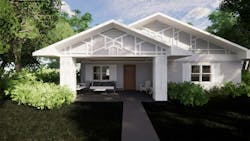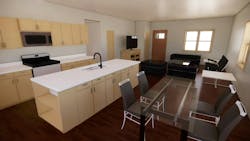As Virginia Tech professors Andrew McCoy and Philip Agee develop their plans to build a 3D printed house in Virginia, they are managing countless details, from local building codes to technical requirements for ready-mix concrete. But they are also keeping the big picture in mind as they experiment with this revolutionary home building technology.
“The builder is the key vote,” says McCoy, director of the Virginia Center for Housing Research and a professor of building construction at Virginia Tech, a 37,000-student public university in Blacksburg, Va. “Whether the builder endorses it or vetoes it, it is the key vote.”
The two researchers come to that perspective after years spent in the construction industry, where they have seen the challenges faced by both home builders and home buyers. “In rural markets, there are jobs, but there isn’t enough housing,” explains McCoy, who thinks 3D printing technology might offer a solution for markets that aren’t dense enough to attract or support traditional home builders.
RELATED: World’s First On-site 3D Printed Apartment Building Begins Construction
From the builder side, both McCoy and Agee see 3D printed homes as a way to address ongoing labor shortages both by reducing the labor required and creating a new category of tech-oriented construction jobs.
“3D concrete printing can be a way to attract a new generation to the housing industry,” says Agee, an assistant professor of building construction and housing studies at Virginia Tech. That’s particularly important since the industry lost an estimated 2.2 million jobs between 2006 and 2010 due to the housing bust. “We never backfilled after the recession,” McCoy says.
Enter technology. Thanks to a $500,000 grant from Virginia Housing, the two are using the Danish COBOD BOD2 modular construction printer to design and produce the 3D printed house in collaboration with Century Concrete, the Better Housing Coalition of Richmond (Va.), and Alquist 3D, which will be the company actually printing the house. Alquist has also agreed to print 3D houses in Virginia for two years after this first demonstration home has been completed, according to McCoy.
Building a 3D Printed House
The professors’ goals are ambitious. They want to create a demonstration 3D printed house that is affordable to produce, energy efficient to operate, appealing to homeowners, and allowable to local building authorities in Virginia. “It’s really challenging when you think about the appropriate design as well as the regulatory process and how it will be accepted in the marketplace,” says Agee.
Finances matter too. Based on the terms of the grant and the affordability goals, the maximum sales price for the home is approximately $210,000, not including land, which would serve buyers making 80% of the area median income in areas such as Henrico County, Va., and James City County, Va.
As of late March, though, the team had not finalized a site for the 3D printed house, although they expect the house to be located in the Richmond, Va., area. “Inexpensive land comes with a lot of strings attached,” notes McCoy, who estimates the actual production cost of the house to be around $180,000.
In terms of the home design itself, the professors are currently planning a three-bedroom, two-bathroom, single-story home between 1,400 and 1,500 square feet. “The printer can go as high as 10 feet,” McCoy explains. “You can add modules to build higher, but we didn’t want to make it too complicated.”
3D Printed Homes Can Be Energy Efficient Homes
While the design is simple, the expectations are high: the professors are looking to create a home that is 50 percent more energy efficient than code. “We are designing not just for the initial cost, but also for durability and operation,” McCoy says.
Agee agrees. “We don’t want to solve the production cycle problem only to produce a house that is uncomfortable or unaffordable in its first cost or its operating costs.”
In terms of the building envelope, they plan to achieve that energy efficiency with a cavity wall, which calls for 6 inches of open-cell spray foam insulation sandwiched between a 2-inch-thick 3D printed concrete wall on each side. A daylighting study will help them determine the right size and placement of windows, and a thermal study will help the researchers identify and manage any energy loss or comfort issues due to anticipated thermal bridges in the house.
The house will also include a ducted heat pump for heating and cooling, an energy recovery ventilator for fresh air circulation, low-flow plumbing fixtures, and Energy Star appliances.
As for the COBOD printer itself, it is expected to arrive in Virginia in May.
When Will 3D Printed Houses Be Available?
After Alquist's four-plus years of research into the 3D printing technology, it's unclear when they will be ready to build for the masses. Though the technology is promising, it is also new, and may take time to fully develop a systematic nation-wide practice. The company is also investing their time and research into other 3D printed structures, such as elevators and roads.
Quick Facts
What: First 3D printed house in Virginia.
Why: To demonstrate the affordability, energy efficiency, and scalability of 3D printed houses.
Where: Richmond, Va., area.
Who: Virginia Center for Housing Research, Virginia Tech, Century Concrete, the Better Housing Coalition of Richmond (Va.), Alquist 3D, RMD Construction, and McClure.
How: $500,000 grant from Virginia Housing, which covers the cost of the $350,000 COBOD printer, mixer, materials, and other costs.
When: COBOD BOD2 3-D printer is expected to arrive in May. Printing could begin as early as June.

